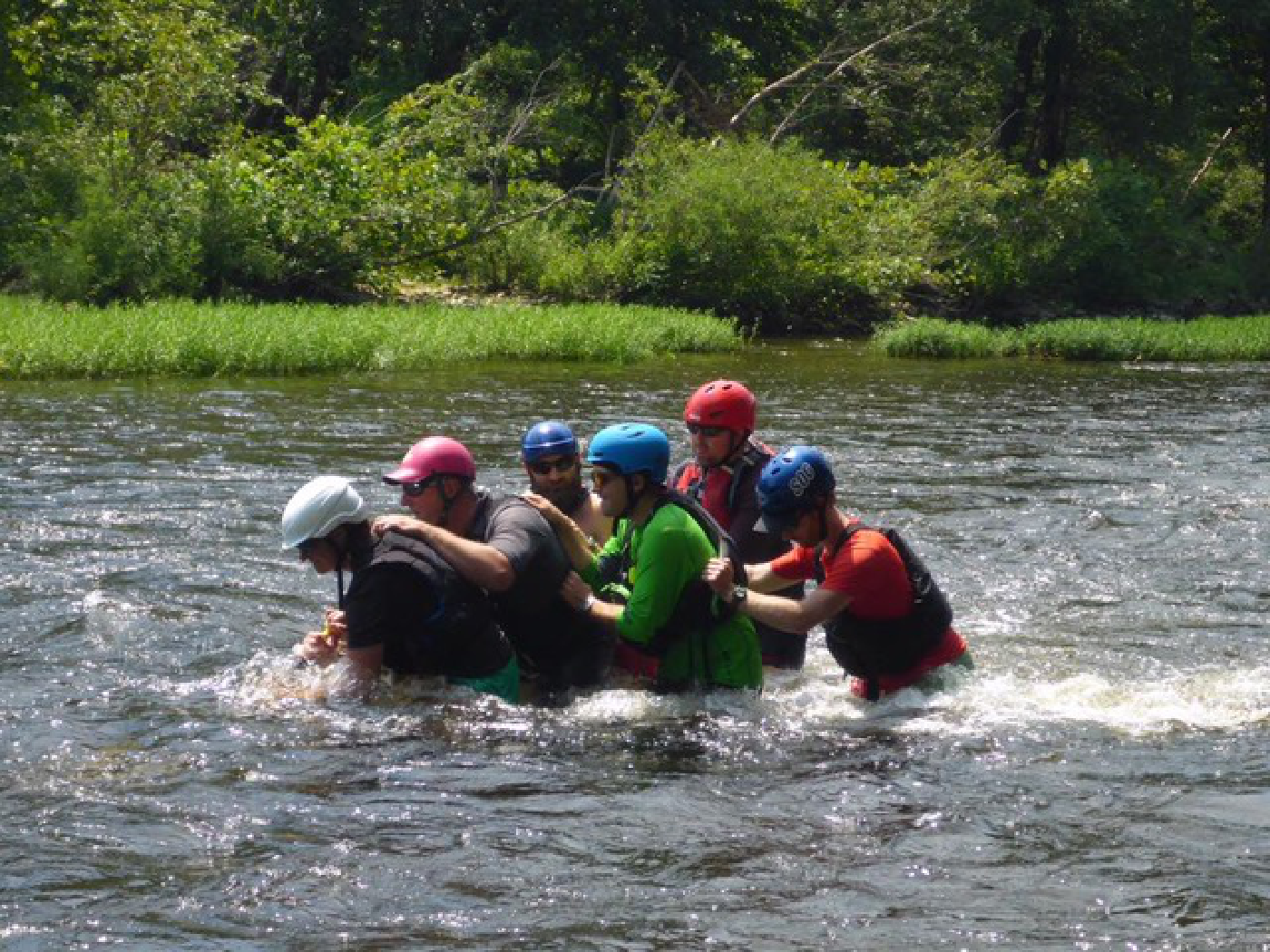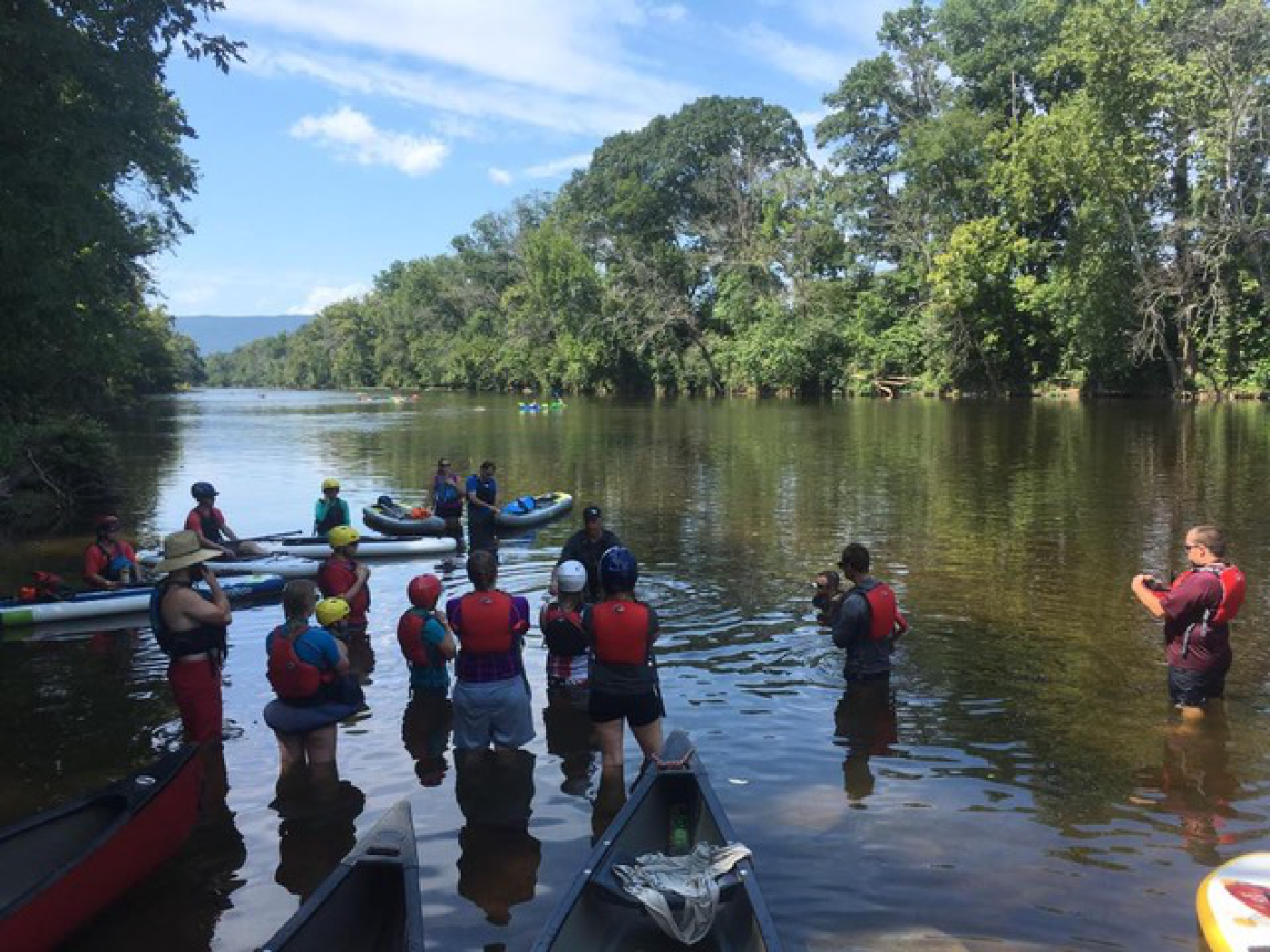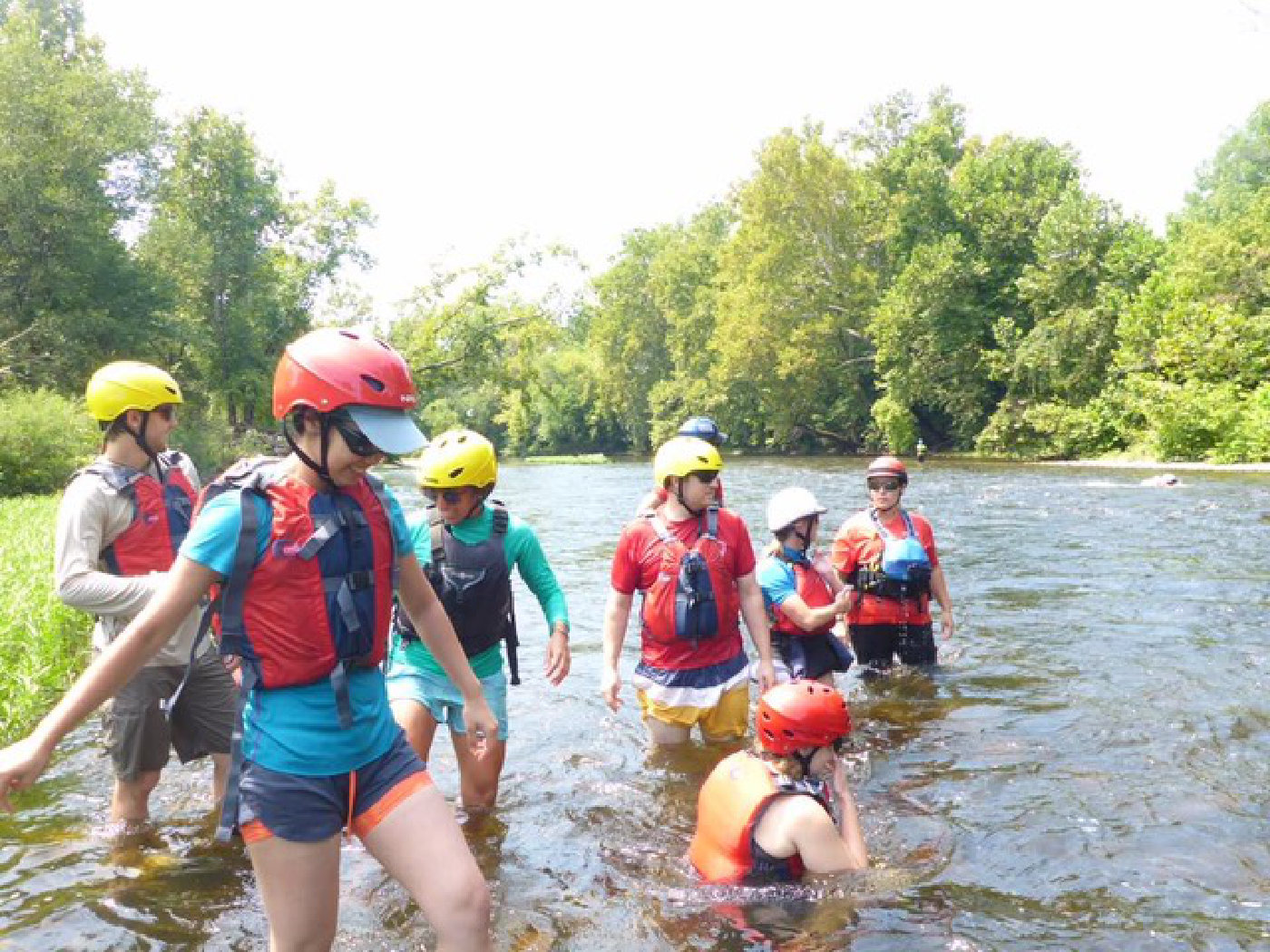In August of 2017, a group of medical residents descended on New Castle, VA for a three day Resident Wilderness Medicine Weekend focused on swift water rescue and related injury management. They learned to develop and execute key self-rescue skills, identify and avoid river hazards, demonstrate strategies for early management of river accidents, and practice methods for recovering swimmers. Additionally, they developed resuscitation skills and practiced care of patients with submersion injuries using high fidelity simulation models. The final day was a capstone float day with application of skills. Attending physicians, as well as current and past wilderness medicine fellows, instructed the group and provided guidance.

The team of instructors and learners were able to network with people with common interests to strengthen the wilderness medicine community. The event organizers hope that this type of long weekend approach to resident education will grow to include multiple other regions with focused instruction on various wilderness medicine core topics. The next course will be in Spring of 2018.
Journal club was led by faculty and discussed current literature pertaining to drowning and submersion injuries, as well pre-hospital and in-hospital management. Here are some potential questions and evidence-based discussion highlighting some of the discussed articles from the perspective of an interested learner.

Question 1: EMS presents with a 45 year old male who fell off his boat and was found without a pulse or respirations. Are the outcomes different for this patient when compared to a traditional cardiac arrest patient?
Outcomes are similar when compared to other out of hospital arrests (OHCA). One article outlining the topic comes from an Australia EMS-based survey on OHCA. EMS attended 336 drowning-related OHCA during the study period. Resuscitation was attempted on 145 (46 percent) patients. Of these, 41 (27 percent) survived to hospital arrival and 12 (8 percent) survived to hospital discharge (5 adults [6 percent] and 7 [12 percent] children). Few patients were found in a shockable rhythm (6 percent) with the majority presenting in asystole (79 percent) or PEA (13 percent). An initial shockable rhythm was found to positively predict survival (AOR 48.70, 95 percent CI: 3.80–624.86) while increased response time (AOR 0.73, 95 percent CI: 0.54–0.98) and saltwater drowning (AOR 0.69, 95 percent CI: 0.01–0.84) were found to negatively predict survival.
Dyson, K., Morgans, A., Bray, J., Matthews, B., & Smith, K. (2013). Drowning related out-of-hospital cardiac arrests: Characteristics and outcomes. Resuscitation, 84(8), 1114-1118. doi:10.1016/j.resuscitation.2013.01.020
Question 2: Similar scenario to the one above, but the patient is 8 years old with more than 30 minutes of resuscitation. What are his predicted outcomes?
Kieboom et al., questioned the merit of prolonged resuscitation (greater than 30 minutes) of drowned pediatric patients with both cardiac arrest and hypothermia. The authors report, “drowned children in whom return of spontaneous circulation is not achieved within 30 minutes of advanced life support have an extremely poor outcome. Good neurological outcome is more likely when spontaneous circulation returns within 30 minutes of advanced life support, especially when the drowning incident occurs in winter. These findings question the therapeutic value of resuscitation beyond 30 minutes in drowned children with cardiac arrest and hypothermia.”
Kieboom, J. K., Verkade, H. J., Burgerhof, J. G., Bierens, J. J., Rheenen, P. F., Kneyber, M. C., & Albers, M. J. (2015). Outcome after resuscitation beyond 30 minutes in drowned children with cardiac arrest and hypothermia: Dutch nationwide retrospective cohort study. Bmj, 350(Feb10 1). doi:10.1136/bmj.h418
Question 3: You see a boater fall out of a kayak in the middle of a set of rapids. He is repeatedly submerged, but ultimately surfaces minimally responsive and breathing on his own. Does he need c-spine protection as he is transported down river and to definitive care?
Watson and Quan found that 11 (0.5 percent) of 2,244 submersion victims had C-spine injuries. All 11 had submerged in open bodies of water, had clinical signs of serious injury, and had a history of diving, motorized vehicle crash, or fall from height. No C-spine injuries occurred in 880 low-impact submersions. For a simple drowning accident without any associated high impact mechanism or other frightening history and no obvious signs of trauma, c-spine protection may not be necessary. However, c-spine precaution should be taken if there is significant concern for concomitant trauma
Watson, R. S., & Quan, L. (1999). Risk Factors For Cervical Spine Injury In Submersion Victims. Critical Care Medicine, 27(Supplement). doi:10.1097/00003246-199912001-00433

Question 4: How about ECMO – should I be activating the system for drowning victims?
Burke et. al. examined 247 patients who received extracorporeal life support (ECLS) following a drowning event between 1986-2015, which showed 51.4 percent survival overall, 71.4 percent survival in patients who did not arrest after drowning, 57 percent survival in those w/ CPR prior to ECLS, and 23.4 percent in patients who received ECPR. “Outcomes in drowning victims supported with ECLS are encouraging: particularly in patients who do not experience cardiac arrest. These data suggest that early initiation of ECLS in drowning patients with respiratory insufficiency may be beneficial to reduce the likelihood of complete cardiopulmonary failure and ECPR. Additionally, ECLS appears to improve the survival in patients who experience post-drowning cardiac arrest.” If you practice where ECMO is an option, a discussion with the team regarding drowning victim could be considered.
Burke, C. R., Chan, T., Brogan, T. V., Lequier, L., Thiagarajan, R. R., Rycus, P. T., & Mcmullan, D. M. (2016). Extracorporeal life support for victims of drowning. Resuscitation, 104, 19-23. doi:10.1016/j.resuscitation.2016.04.005
Question 5: Are those stories about hypothermic patients surviving submerged without a pulse for multiple hours true?
While some of the case reports are indeed true, the data unfortunately is much less promising. A case control study by Quan et. al. found no protective effect of cold water for drowning victims. The most powerful predictor of outcome was estimated submersion time. In this study, 1094 open water drowning victims were analyzed, 78 percent had bad outcomes (74 percent died and 4 percent with severe neurologic sequelae). Of those with good outcomes, 88.2 percent were submerged for less than six minutes, 7.4 percent 6-10 minutes, and 4.3 percent for 11-60 minutes. Victims with good outcomes were 61 percent less likely (95 percent CI: 0.23-0.65) to be submerged for 6 to 10 minutes and 98 percent (95% CI: 0.01-0.04) less likely to be submerged for 11 or more minutes. Water temperature had no association with outcome in this group. As stated in the conclusions, “Recommendations for initiation of rescue and resuscitation efforts should be revised to reflect the very low likelihood of good outcome following submersion greater than 10 minutes.”
Quan, L., Mack, C. D., & Schiff, M. A. (2014). Association of water temperature and submersion duration and drowning outcome. Resuscitation, 85(6), 790-794. doi:10.1016/j.resuscitation.2014.02.024
Question 6: A luxury Alaskan cruise sinks just offshore from Kodiak Island. Do you swim or wait for help in the icy waters?
Ducharme and Lounsbury authored a summary of multiple studies related to cold water immersion and associated swimming survival statistics. The authors summarize their findings best. “Studies conducted in water between 10º and 14ºC indicate that people can swim in cold water for a distance ranging between about 800 and 1,500m before being incapacitated by the cold. The average swimming duration for the studies was about 47 minutes before incapacitation, regardless of the swimming ability of the subjects. Recent evidence shows that people have a very accurate idea about how long it will take them to achieve a given swimming goal despite a threefold overestimation of the absolute distance to swim. The subjects were quite astute at deciding their swimming strategy early in the immersion with 86 percent success, but after about 30 min of swimming or passive cooling, their decision-making ability became impaired.” If you truly think you can make it, go for it now and go quickly.
Ducharme, M. B., & Lounsbury, D. S. (2007). Self-rescue swimming in cold water: the latest advice. Applied Physiology, Nutrition, and Metabolism, 32(4), 799-807. doi:10.1139/h07-042
Bonus: I have been asked to give a lecture on drowning, where I can start my research and what guidelines should I use?
No wilderness medicine discussion is complete without referencing the Wilderness Medical Society Guidelines. This is a great start for providers in all settings and general overview of the literature surrounding drowning epidemiology, rescue, resuscitation, management, disposition, and some special case considerations.
Schmidt, A. C., Sempsrott, J. R., Hawkins, S. C., Arastu, A. S., Cushing, T. A., & Auerbach, P. S. (2016). Wilderness Medical Society Practice Guidelines for the Prevention and Treatment of Drowning. Wilderness & Environmental Medicine, 27(2), 236-251. doi:10.1016/j.wem.2015.12.019